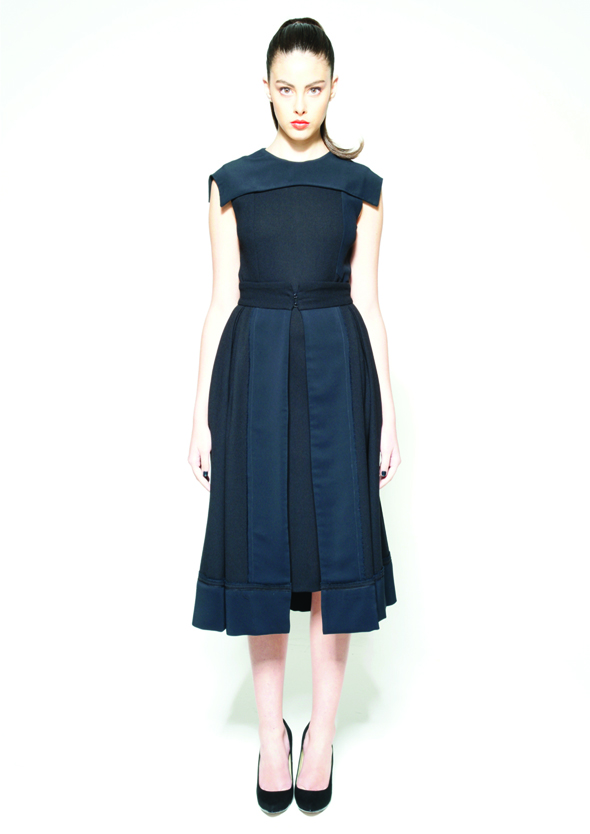
Using her innate eye to balance elegant shapes with classic structures, Colombian-born designer Amelia Toro knows precisely who she designs for. Honoring the ever-present goal to craft timeless pieces for real women, her designs excite nostalgia for the artistic development of the twenties. Possessing a talent for noticing how clothing is able to highlight the natural beauty of a woman, she strives for a classic feel but ensures to include her own twist. Whether through appropriate placement of sheer accents or plunging necklines on demure dresses, by incorporating a personal edge the message rings loud and clear: this is Amelia Toro. Full of soft silks, chiffons and natural fibers, her line is effortlessly sensual. Greatly influenced by her lifetime passion towards dance, it’s clear that the movements of styles like flamenco and ballet have inspired the fluidity of her construction. Surrounded since birth by a family full of creatives – interior designer, architect, playwright, writer, photographer, and director – it was never a question whether or not she would purse an artistic career.
Leaving her home town of Bogotá, Colombia to study at the Rhode Island School of Design and Parsons School of Design in New York, she developed a personal style that was mirrored by functionality and top quality. Between schooling she worked under designers Gianfranco Ferré and Pino Lancetti where she was able to gain invaluable front line work experience in the fashion world. Drawn to the simplistic and graceful styles of icons such as Audrey Hepburn, she has recently fulfilled every designer’s dream – to establish a flagship store. Opening in October 2012 in the coveted, art-centric neighborhood of Chelsea, Manhattan, her pieces can be found spread across the 2,000 square foot gallery-like space. By reaching this successful pinnacle in her career, Toro is a far cry from the young child who once designed clothing for her sisters and paper dolls. With sights set on further expansion into all major US cities, specifically pushing the West Coast, she is grateful for how warmly she has been received by an industry whose exclusivity can be challenging to break into.
Believing in beautiful, comfortable clothing made from the absolute highest-quality fabrics is the foundational force driving Toro’s fashion house; however, it doesn’t stop there. Unlike some designers who are starved for notoriety and driven to see their face splashed across glossy magazines, she realizes that her art isn’t limited to being simply a creative personal outlet. When it comes down to it, designing is a major part, but not everything. Toro has dedicated herself for the last twelve years to working alongside Indian groups throughout Latin America in support of their traditional art. Instead of standing on the sidelines watching as culture grows increasingly forgotten, she has chosen to use her name in fashion to help promote what otherwise may be a dying tradition. To honor the craft of the Putumayo Indigenous people, Wayuu Tribe, and the Panamanian Kuna group, she incorporates their pieces and designs into her garments. By using colors, fabrics, techniques, and shapes that stem from their heritage, Toro challenges how fashion is viewed while simulta- neously providing a platform for historical designs.

When you think about what makes a women’s line successful, most often everything comes down to the level of confidence she feels when wearing the clothes. The perfect marriage is one that boasts an air of understated sexy with an overall timelessness. Through meticulous detailing each piece is brought to life in a unique and cohesive way. Toro’s Spring 2013 collection showcases jackets, streamlined pants, and several dresses – varying from short, whimsical LBDs to refined, draping pearl calf-length dresses. Navy, steel, and turquoise blues are intermittently splashed throughout the collection, and the indigenous geometric shapes and graphic prints are subtly weaved in. A standout is a muted gold and amber highlight jacket that is suitable for daytime and night wear with its rigid collar and crop sleeve.
Toro has resisted having her clothes made overseas, and instead has chosen to manufacture everything in South America where there is a deep tradition of garment making. She currently has employed forty women, who are primarily single mothers. By doing so, she sees this as a way to encourage social and financial independence in a society pervaded by inequalities towards women. Providing jobs and equipping them with the necessary skills and tools to earn a fair living, she ventures beyond fashion and into humanitarianism. Seeking to raise the poverty bar for as many women as possible through her trade is an admirable quality in not only a designer, but any individual.
Amelia Toro does pay attention to the cornerstones of women’s fashion – style, comfort, functionality – when she designs her stunningly elegant collections, yet she also works daily to provide underprivileged women the opportunity to better their social situations. As well as presenting her line in the New York flagship, she is also carried in prestigious store fronts such as Barney’s, Saks Fifth Ave., and Maxfield. With a far-reaching business model that incorporates heritage, goodwill, and high fashion, there is no doubt that the Amelia Toro brand will be represented by style-minded, socially conscious women around the world.
Text by Morgan K. Sterns

